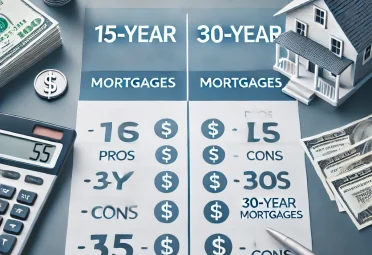How to Refinance Your Mortgage and Save Money in the Long Run
If one is seeking to reduce expenses on mortgage payments, a comprehension of mortgage refinancing can prove invaluable. This material aims to provide a comprehensive overview of the refinancing process, encompassing the rationale behind considering this financial strategy, as well as the advantages and potential drawbacks associated with it.
By diving into the steps involved in refinancing, highlighting crucial factors for contemplation, and offering advice on optimizing cost savings, individuals can enhance their understanding of this financial maneuver. Whether the objective is to secure lower interest rates, consolidate debt, or enhance one’s credit score, mortgage refinancing may serve as a pivotal tool for achieving sustained financial efficiency.
Understanding Mortgage Refinancing
Comprehension of Mortgage Refinancing entails diving into the process of substituting an existing loan with a new one, typically to achieve long-term cost savings. This financial tactic enables property owners to modify their interest rate, loan duration, and leverage home equity in pursuit of specific financial objectives.
Through the act of refinancing, property owners can capitalize on lower interest rates to diminish their monthly mortgage payments or abbreviate the loan’s duration to expedite debt repayment. Utilizing home equity via refinancing can finance substantial expenditures like home improvements or educational costs. It is imperative to assess the advantages in light of potential closing expenses to ensure that the overall savings align with your financial goals. Ultimately, strategic mortgage refinancing can significantly contribute to enduring financial stability and assist individuals in more effectively managing their financial obligations.
What is Mortgage Refinancing?
Mortgage refinancing is the process by which an individual obtains a new mortgage to replace an existing one. This procedure typically entails collaborating with a loan officer to evaluate the individual’s financial standing, conduct an appraisal of the property, and review the credit report to ascertain the eligibility for a refinanced loan.
The initial step in the refinancing process involves engaging with a qualified loan officer who will provide guidance on the diverse options available based on the individual’s financial position. Loan officers are essential in helping withdividuals in comprehending the terms and conditions associated with various refinancing programs.
After the initial consultation, a critical stage in the process is the property appraisal, where a proficient professional assesses the current market value of the property. This evaluation is instrumental in determining the potential loan amount that the individual may qualify for during the refinancing procedure.
Furthermore, the individual’s credit report is of paramount importance as lenders utilize this information to evaluate the creditworthiness of the individual and establish the interest rate that may be offered for the refinanced mortgage.
Reasons to Consider Refinancing
There are several reasons to contemplate refinancing a mortgage, including the exploration of various refinancing options to reduce monthly payments, consolidate debt, or access home equity through a cash-out refinance.
Refinancing presents homeowners with the opportunity to modify the terms of their mortgage loans to better align with their financial objectives. Debt consolidation stands out as a significant advantage of refinancing, enabling individuals to merge high-interest debts into a single, more manageable monthly payment. Cash-out refinancing allows homeowners to utilize the equity in their homes to procure funds for essential expenses such as home renovations, educational expenses, or debt settlement. These refinancing alternatives offer a strategic method for homeowners to optimize their financial position and attain increased stability.
The Refinancing Process
The process of refinancing entails several essential steps, commencing with the consultation of a loan officer, the completion of a property appraisal, and a review of one’s credit report to ascertain eligibility for refinancing.
- Upon completion of the initial consultation with an experienced loan officer, individuals will be guided through the requisite documentation and provided support in completing essential forms.
- Subsequently, the pivotal step involves a property appraisal, during which a professional appraiser evaluates the value of the home. This assessment aids in determining the borrowing amount and assessing whether the property aligns with the lender’s criteria.
Concurrently, a thorough examination of the credit report is conducted to assess creditworthiness and financial history, both crucial components of the refinancing process.
Steps to Refinancing Your Mortgage
When considering mortgage refinancing, it is imperative to follow key steps that include utilizing a refinance calculator to evaluate potential savings, establishing a clear refinance timeline to monitor progress, and preparing thoroughly for the refinancing closing process.
Utilizing a refinance calculator enables homeowners to input relevant information such as the current loan balance, interest rate, and prospective new terms to efficiently determine potential savings.
Setting a practical refinance timeline is essential for maintaining organization and adhering to deadlines for submitting documentation and completing requisite paperwork.
Comprehending the refinance closing procedure entails a detailed review and signing of documents, payment of closing costs, and finalization of new loan terms in collaboration with the lender.
Important Factors to Consider
When contemplating refinancing, it is essential to consider several key factors to ensure knowledge-based decision making. These include analyzing one’s home equity, evaluating credit score, assessing debt-to-income ratio, and understanding the loan-to-value ratio.
Home equity is a critical determinant of refinancing options as it signifies the variance between the current market value of the property and the outstanding mortgage balance. A higher equity percentage often leads to more favorable refinancing terms, such as lower interest rates or exemption from private mortgage insurance requirements.
Likewise, credit score plays a pivotal role in determining the interest rates for which an individual qualifies. Lenders utilize credit scores to assess creditworthiness and evaluate the risk associated with extending credit.
The debt-to-income ratio reflects one’s capacity to manage current and prospective debt, thereby influencing lenders’ decisions on offering refinancing options. Additionally, the loan-to-value ratio, which compares the loan amount to the appraised value of the property, is crucial in assessing the risk associated with refinancing.
By comprehensively understanding and considering these factors, individuals can make informed and advantageous refinancing decisions that align with their financial objectives.
Benefits of Refinancing Your Mortgage
The act of refinancing a mortgage can yield substantial advantages, such as obtaining lower interest rates, reducing monthly payments, opportunities for consolidating debts, and the chance to enhance one’s credit score through timely repayments.
Securing a reduced interest rate through the refinancing process can lead to significant savings over the loan’s duration. Lower monthly payments can offer financial relief and augment discretionary income. Debt consolidation presents another benefit, enabling the consolidation of high-interest debts into a single, more manageable monthly payment. This streamlined approach not only simplifies financial matters but also decreases the overall interest expenditure.
Timely repayments towards the refinanced mortgage can have a positive impact on one’s credit score. This could potentially lead to improved loan terms and future opportunities.
Lower Interest Rates and Monthly Payments
Refinancing can result in decreased interest rates and monthly payments, particularly when transitioning from an adjustable-rate mortgage to a fixed-rate mortgage, offering stability and the potential for long-term financial gains.
The transition from an adjustable-rate to a fixed-rate mortgage presents multiple benefits. With a fixed rate, the monthly payment remains steady throughout the loan’s duration, providing predictability in financial planning. Unlike adjustable rates that are subject to market fluctuations, a fixed rate ensures consistent payments, mitigating the risk of unforeseen increases.
Fixed-rate mortgages provide a safeguard against rising interest rates, providing assurance that your payments will not escalate over time. Through refinancing and securing a lower fixed interest rate, substantial cost savings can be achieved over the loan’s lifespan.
Consolidating Debt and Improving Credit Score
Mortgage refinancing presents individuals with the opportunity to consolidate high-interest debts, decrease their overall debt-to-income ratio, and establish consistent payment patterns that can contribute to the enhancement of their credit scores in the long term.
Through the process of mortgage refinancing, individuals can amalgamate diverse debts into a singular monthly payment, thereby simplifying their financial responsibilities and potentially reducing the aggregate interest accrued over the loan’s lifespan. This strategic consolidation not only streamlines the debt repayment process but also aids in diminishing the debt-to-income ratio, a pivotal metric in assessing one’s financial standing. By prudently managing the refinanced mortgage, individuals can exhibit their creditworthiness and commitment to meeting financial obligations, consequently exerting a favorable influence on their credit score over an extended period.
Potential Drawbacks of Refinancing
Though refinancing presents advantages, it is imperative to acknowledge the possible disadvantages that come with it, such as incurring closing expenses and potentially elongating the loan term, which could influence the overall borrowing cost.
The closing fees linked with refinancing have the potential to accumulate significantly and might surpass the savings garnered from a reduced interest rate. Extending the loan duration through refinancing could lead to higher interest payments throughout the loan’s lifespan, thereby augmenting the total sum paid. It is crucial to meticulously evaluate these aspects to ascertain whether the merits of refinancing surpass the potential downsides in every unique circumstance.
Closing Costs and Fees
One of the potential disadvantages of refinancing is the accrual of closing costs and fees, which may include refinance fees, points, and the necessity for a Closing Disclosure document that delineates the financial specifics of the transaction.
These expenses and charges linked to refinancing play a pivotal role in ascertaining the overall financial implications of the procedure. Refinance fees encompass a variety of costs like application fees, appraisal fees, and title search fees, which have the potential to accumulate significantly.
Points, commonly known as discount or origination points, are fees remitted to the lender to secure a reduced interest rate on the loan. It is imperative to comprehend the contents of the Closing Disclosure document as it furnishes a comprehensive breakdown of all associated costs, aiding borrowers in making well-informed decisions.
Extended Loan Term
Refinancing has the potential to elongate the loan term, resulting in decreased monthly payments while concurrently increasing the total interest paid over time. This phenomenon occurs due to the extended repayment period and larger principal balance associated with the refinanced loan.
By extending the loan term through refinancing, the repayment period is typically prolonged, distributing the principal balance across an extended timeframe. While this adjustment may alleviate immediate financial strain by reducing monthly payments, it is imperative to assess its implications on the overall borrowing cost.
A lengthier term may necessitate paying a higher amount of interest over the loan’s lifespan, even if the monthly payments are more affordable. Borrowers must carefully evaluate the benefits of reduced monthly payments against the potential rise in total interest expenses when deliberating on a loan term.
Tips for Maximizing Savings through Refinancing
To optimize savings through the refinancing process, it is advisable to consider strategic methodologies such as formulating a refinancing strategy, establishing a clear timeline for the procedure, and engaging in negotiations with lenders to secure advantageous terms.
Developing a meticulously planned refinance strategy entails evaluating one’s current financial standing, outlining achievable objectives for the refinance, and exploring the various loan options that are accessible. Setting a specified timeline for the refinancing endeavor facilitates organization and progress, enabling individuals to leverage favorable market conditions effectively.
Efficiently negotiating with lenders necessitates a comprehensive examination of interest rates, loan terms, and potential concessions. By approaching these discussions with thorough preparation and assertiveness, the likelihood of securing a refinancing agreement that aligns with one’s financial goals is significantly enhanced.
Timing Your Refinancing
The timing factor is of paramount importance in making refinancing decisions, as various elements such as rate lock options, approval timelines, and well-informed refinancing choices all contribute to the overall success of the refinancing endeavor.
When contemplating mortgage refinancing, the timing of the rate lock decision can significantly influence the interest rate obtained. Choosing to lock in a rate when market conditions are favorable can result in securing a lower rate for the new loan. Understanding the intricacies of the approval processes associated with refinancing is essential for effectively managing expectations and mitigating potential delays. Making informed decisions based on individual financial objectives and current market dynamics is pivotal in maximizing the advantages derived from the refinancing process.
Negotiating with Lenders
Participating in negotiations with lenders throughout the refinancing process entails the submission of a comprehensive refinance application, the provision of necessary documentation, and the potential establishment of a rate lock mechanism to mitigate risks associated with interest rate variations.
The completion of a thorough refinance application holds paramount importance as it enables lenders to conduct a precise assessment of your financial status. The assembly of all requisite refinance documentation, including income statements, credit reports, and property details, serves to streamline the approval procedure. Evaluating rate lock alternatives offers the advantage of a consistent interest rate, shielding against fluctuations in market rates. These actions collectively ensure a more seamless refinancing process and have the potential to yield improved terms and financial savings in the long term.


